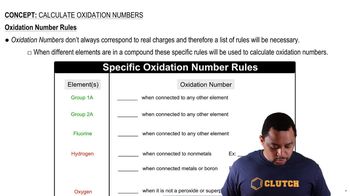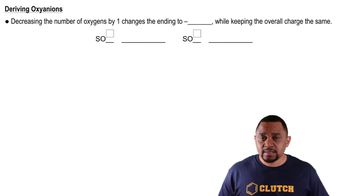Ch.22 - The Main Group Elements

Chapter 22, Problem 110
Assign oxidation numbers to each element in the following ions. (c) C2O4 2-
 Verified step by step guidance
Verified step by step guidance1
Step 1: Remember the rules for assigning oxidation numbers. The oxidation number of an atom in its elemental form is 0. The oxidation number of a monoatomic ion is equal to its charge. The sum of the oxidation numbers in a neutral compound is 0, and in an ion it equals the ion's charge.
Step 2: Identify the elements in the ion. In the ion C2O4 2-, there are two elements: carbon (C) and oxygen (O).
Step 3: Assign oxidation numbers based on the rules. Oxygen is in group 16 on the periodic table and usually has an oxidation number of -2. Since there are four oxygen atoms, the total oxidation number for oxygen in the ion is -8.
Step 4: Use the rule that the sum of the oxidation numbers in an ion equals the ion's charge to find the oxidation number of carbon. The ion C2O4 2- has a charge of -2, so the sum of the oxidation numbers is -2. Since the total oxidation number for oxygen is -8, the total oxidation number for carbon must be +6 to make the sum -2.
Step 5: Since there are two carbon atoms in the ion, the oxidation number for each carbon atom is +6 divided by 2, or +3. So, the oxidation number of carbon in the ion C2O4 2- is +3.

Verified video answer for a similar problem:
This video solution was recommended by our tutors as helpful for the problem above.
Was this helpful?
Key Concepts
Here are the essential concepts you must grasp in order to answer the question correctly.
Oxidation Number
An oxidation number, or oxidation state, is a value assigned to an element in a compound that reflects its degree of oxidation or reduction. It indicates the number of electrons an atom can gain, lose, or share when forming chemical bonds. The rules for assigning oxidation numbers include that the oxidation state of an element in its elemental form is zero, and for monoatomic ions, it equals the charge of the ion.
Recommended video:
Guided course

Oxidation Numbers
Rules for Assigning Oxidation Numbers
There are specific rules for assigning oxidation numbers, which include: the oxidation number of hydrogen is +1, oxygen is typically -2, and the sum of oxidation numbers in a neutral compound is zero, while in a polyatomic ion, it equals the ion's charge. These rules help in systematically determining the oxidation states of elements in various compounds and ions.
Recommended video:
Guided course

Oxidation Number Rules
Polyatomic Ions
Polyatomic ions are ions composed of two or more atoms covalently bonded, which carry a net charge due to the loss or gain of electrons. In the case of the ion C2O4 2-, known as the oxalate ion, it consists of two carbon atoms and four oxygen atoms, and the overall charge of -2 must be accounted for when assigning oxidation numbers to each element within the ion.
Recommended video:
Guided course

Polyatomic Ion Variations
Related Practice
